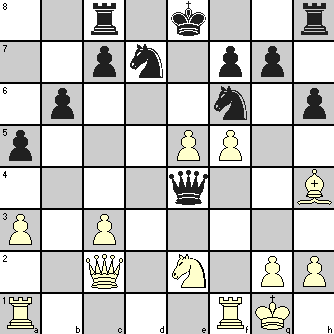Chess Sacrifice as Chess Tactics identified sacrifice as a tactics to gain tempo. Gaining a tempo is an important chess tactics that provides you with an initiative (see Chess Sacrifice as a Chess Tactics: to seize initiative) whereby you take a lead forcing the opponent to passively follow what your moves dictate! You achieve a tempo by threatening to capture a piece, or to gain substantial material, or to deliver a check – any of which will need the opponent to attend to these immediate threats, shelving for the time being the plans he wanted to pursue. Diverting the opponent’s plan, you get enough time to continue with your attack to a successful end.
In our recent posting of some Chess Trivia on current list of Grandmasters, we referred to Andre Lilienthal, the oldest living Grandmaster at 98! While fervently wishing him to complete his century, we thought that the best tribute we could pay is to use one of his brilliant games against a player no less than the great Capablanca.
The game hardly needs any comment and we use it to show the use of sacrifice as a chess tactics to gain tempo and how a tempo can continue to be maintained.
You have already been introduced to Lilienthal (b. 1911), and Capablanca (1888-1942) certainly does not need it, and if we were to start on those lines, this article could never be completed within bounds of reasonable space and time!
This game was played at Hastings tournament in 1935. Seeing that it is a short game of 26 moves and because of the way the game was played, we are reproducing the full game here.
| 1. | d4 | Nf6 | ||
| 2. | c4 | e6 | ||
| 3. | Nc3 | Bb4 | ||
| 4. | a3 | Bxc3+ | ||
| 5. | bxc3 | b6 | ||
| 6. | f3 | d5 | ||
| 7. | Bg5 | h6 | ||
| 8. | Bh4 | Ba6 | ||
| 9. | e4 | Bxc4 | ||
| 10. | Bxc4 | dxc4 | ||
| 11. | Qa4+ | Qd7 | ||
| 12. | Qxc4 | Qc6 | ||
| 13. | Qd3 | Nbd7 | ||
| 14. | Ne2 | Rd8 | ||
| 15. | 0-0 | a5 | ||
| 16. | Qc2 | Qc4 | ||
| 17. | f4 | Rc8 | ||
| 18. | f5 | e5 | ||
| 19. | dxe5 | Qxe4 |
(Capablanca)

(Lilienthal)
| 20. | exf6 | Qxc2 | White gains tempo by capturing the Knight that was providing support to the Queen. Now White was threatening to capture the unsupported Black Queen. That the reverse was also true was the point on which White made his Queen sacrifice! If Black captured the f6 pawn with his Knight to support his Queen, White could initiate Queen exchange leaving Black with a Knight short! |
|
| 21. | fxg7 | Rg8 | White continued to maintain tempo by threatening to capture the Rook, in the process promoting his pawn to Queen and delivering check to Black King – all in one move! So Black had to guard against this threat. |
|
| 22. | Nd4 | Qe4 | White still maintains tempo by shifting focus to other end to threaten the Black Queen. But there was a deadlier threat of quick mate starting with 23. Rae1+. Black had to give up his Queen to meet the multiple threats! |
|
| 23. | Rae1 | Nc5 | 23. … Qxe1 24. Rxe1+ Ne5 25. Rxe5+ | |
| 24. | Rxe4+ | Nxe4 | ||
| 25. | Re1 | Rxg7 | ||
| 26. | Rxe4+ | Kd7 | and Black resigned with this. White’s 27. Bf6 followed by 28. Nb5 would pose problems too much to handle for Black. |
It can be said that Lilienthal played a perfect game reminiscent of Capablanca in his prime!
Watch Actual Game
Other Interesting Related Posts you should read:
- Chess Sacrifice as a Chess Tactics: to gain time to promote a passed pawn
- Chess Sacrifice as a Chess Tactics: diverting opponent’s piece from a square to gain advantage
- Chess Sacrifice as a Chess Tactics: to gain time to attack
- Chess Sacrifice as a Chess Tactics: to seize initiative
- Chess Sacrifice as a Chess Tactics: timing in keeping with force accumulation



16 Comments
Interesting game. Nice to see such old games being discussed. Wish Lilenthal a century
@Sandy as the saying goes OLD IS GOLD.
I hate this opening PERIOD.
[...] Read more from the original source: Chess Sacrifice as a Chess Tactics: to gain tempo | [...]
Kramnik games are good examples of some postional sacs as well, I know he is not that great tactician but his positional game play is great, you should do some of his games.
Now that is a good combination to beat the hero of that time Capablanca.
Hey the writer of this post can you please tell me if jose r capablanca was running out of time in this game?
[...] Chess Sacrifice as a Chess Tactics: to gain tempo Chess Sacr [...]
Looking at the game, i see the guy playing vs raul was not bad at all, i am sure he had some harsh time in life otherwise he would have been probably in list of top players.
[...] Chess Sacrifice as a Chess Tactics: to gain tempo Chess Sacr [...]
@Hunter why is it that you hate the opening? I for one love the opening it is a solid chess opening.
thanks for the nice post. The video of the entire game at the end of the article is the plus as we can not only get to know of the old grandmasters, but also play the game instantly in this blog.
t
@Paul
We will keep it in mind.
@Tal
No, we have no such information. But it is a fact that in 1935, Capablanca was 47 yrs. old and certainly past his prime whereas Lilienthal was only 24 yrs. old. If you read the last sentence, you will see our comment that Lilienthal’s play was reminiscent of Capablanca in his prime.
@James
No, not bad at all if you consider that he played against most of World Men’s and Women’s Champions of his playing days and defeated Lasker, Capablanca, Alekhine, Euwe, Botvinnik, Smyslov, and Vera Menchik.
Though he played against Petrosian and Karpov also, I did not find any record of his win against them. I do not know if he at all played against Tal or Spassky.
The game referred in the article was Lilienthal’s most celebrated victory.
[...] Chess Sacrifice as a Chess Tactics: to gain tempo Chess Sacr This entry was posted on Wednesday, June 24th, 2009 at 5:59 am and is filed under Chess Articles. You can follow any responses to this entry through the RSS 2.0 feed. You can skip to the end and leave a response. Pinging is currently not allowed. [...]